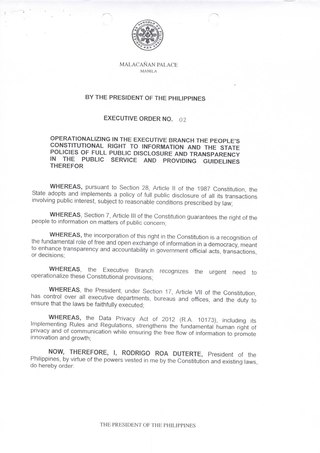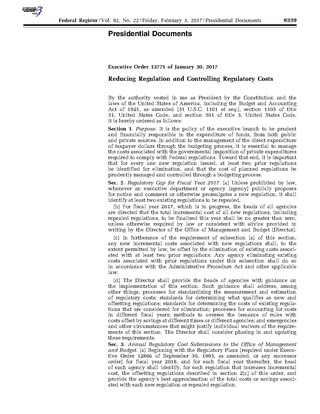Administrative law is a division of law governing the activities of executive branch agencies of government. Administrative law includes executive branch rule making, adjudication, and the enforcement of laws. Administrative law is considered a branch of public law.

The Office of Management and Budget (OMB) is the largest office within the Executive Office of the President of the United States (EOP). OMB's most prominent function is to produce the president's budget, but it also examines agency programs, policies, and procedures to see whether they comply with the president's policies and coordinates inter-agency policy initiatives.
In the United States government, independent agencies are agencies that exist outside the federal executive departments and the Executive Office of the President. In a narrower sense, the term refers only to those independent agencies that, while considered part of the executive branch, have regulatory or rulemaking authority and are insulated from presidential control, usually because the president's power to dismiss the agency head or a member is limited.

In the United States, an executive order is a directive by the president of the United States that manages operations of the federal government. The legal or constitutional basis for executive orders has multiple sources. Article Two of the United States Constitution gives presidents broad executive and enforcement authority to use their discretion to determine how to enforce the law or to otherwise manage the resources and staff of the executive branch. The ability to make such orders is also based on expressed or implied Acts of Congress that delegate to the president some degree of discretionary power. The vast majority of executive orders are proposed by federal agencies before being issued by the president.

The Federal Register is the official journal of the federal government of the United States that contains government agency rules, proposed rules, and public notices. It is published every weekday, except on federal holidays. The final rules promulgated by a federal agency and published in the Federal Register are ultimately reorganized by topic or subject matter and codified in the Code of Federal Regulations (CFR), which is updated quarterly.
In administrative law, rulemaking is the process that executive and independent agencies use to create, or promulgate, regulations. In general, legislatures first set broad policy mandates by passing statutes, then agencies create more detailed regulations through rulemaking.

The Office of Information and Regulatory Affairs is a Division within the Office of Management and Budget (OMB), which in turn, is within the Executive Office of the President. OIRA oversees the implementation of government-wide policies in, and reviews draft regulations under, Executive Order 12866, the Paperwork Reduction Act, and the Information Quality Act.
United States federal administrative law encompasses statutes, regulations, rules, common law rulings, and directives issued by the Office of Information and Regulatory Affairs in the Executive Office of the President, that together define the extent of powers and responsibilities held by administrative agencies of the United States government. The executive, legislative, and judicial branches of the U.S. federal government cannot always directly perform their constitutional responsibilities. Specialized powers are therefore delegated to an agency, board, or commission. These administrative governmental bodies oversee and monitor activities in complex areas, such as commercial aviation, medical device manufacturing, and securities markets.
A regulatory agency or independent agency is a government authority that is responsible for exercising autonomous dominion over some area of human activity in a licensing and regulating capacity.

The Safe Drinking Water Act (SDWA) is the principal federal law in the United States intended to ensure safe drinking water for the public. Pursuant to the act, the Environmental Protection Agency (EPA) is required to set standards for drinking water quality and oversee all states, localities, and water suppliers that implement the standards.
Jim Tozzi is an American lobbyist, currently the head of the Center for Regulatory Effectiveness, an industry-supported, for-profit lobbying organization that describes itself as a "regulatory watchdog." Formerly, he was a regulatory official of the United States Office of Management and Budget (OMB). His partner for many years was Thorne G. Auchter and they ran two main lobbying organisations, Federal Focus and Multinational Business Services.

The Paperwork Reduction Act of 1980 is a United States federal law enacted in 1980 designed to reduce the total amount of paperwork burden the federal government imposes on private businesses and citizens. The Act imposes procedural requirements on agencies that wish to collect information from the public. It also established the Office of Information and Regulatory Affairs (OIRA) within the Office of Management and Budget (OMB), and authorized this new agency to oversee federal agencies' collection of information from the public and to establish information policies. A substantial amendment, the Paperwork Reduction Act of 1995, confirmed that OIRA's authority extended over not only agency orders to provide information to the government, but also agency orders to provide information to the public.

The Regulatory Flexibility Act (RFA) is perhaps the most comprehensive effort by the U.S. federal government to balance the social goals of federal regulations with the needs and capabilities of small businesses and other small entities in American society.
Midnight regulations are United States federal government regulations created by executive branch agencies during the transition period of an outgoing president's administration.
The, United States Environmental Protection Agency (EPA) began regulating greenhouse gases (GHGs) under the Clean Air Act from mobile and stationary sources of air pollution for the first time on January 2, 2011. Standards for mobile sources have been established pursuant to Section 202 of the CAA, and GHGs from stationary sources are currently controlled under the authority of Part C of Title I of the Act. The basis for regulations was upheld in the United States Court of Appeals for the District of Columbia in June 2012.

Philippine President Rodrigo Duterte signed Executive Order No. 02, also known as the Freedom of Information (FOI) Program, on July 23, 2016, in Davao City. The executive order established the first freedom of information (FOI) Program in the Philippines covering all government offices under the Executive Branch. It requires all executive departments, agencies, bureaus, and offices to disclose public records, contracts, transactions, and any information requested by a member of the public, except for matters affecting national security and other information that falls under the inventory of exceptions issued by Executive Secretary Salvador Medialdea. The landmark order was signed two days before Duterte delivered his first State of the Nation Address and just three weeks after he assumed the presidency on June 30, 2016.

Executive Order 13771 —entitled "Reducing Regulation and Controlling Regulatory Costs"— was an executive order signed by U.S. President Donald Trump on January 30, 2017.
Executive Order 13992, officially titled Revocation of Certain Executive Orders Concerning Federal Regulation, was signed on January 20, 2021, and is the eighth executive order signed by U.S. President Joe Biden. The order works to withdraw certain federal regulation executive orders from previous administrations.
Executive Order 14110, titled Executive Order on Safe, Secure, and Trustworthy Development and Use of Artificial Intelligence is the 126th executive order signed by U.S. President Joe Biden. Signed on October 30, 2023, the order defines the administration's policy goals regarding artificial intelligence (AI), and orders executive agencies to take actions pursuant to these goals. The order is considered to be the most comprehensive piece of governance by the United States regarding AI.






